After devastation, I returned to one of the world’s most amazing countries
By Andrew Bain
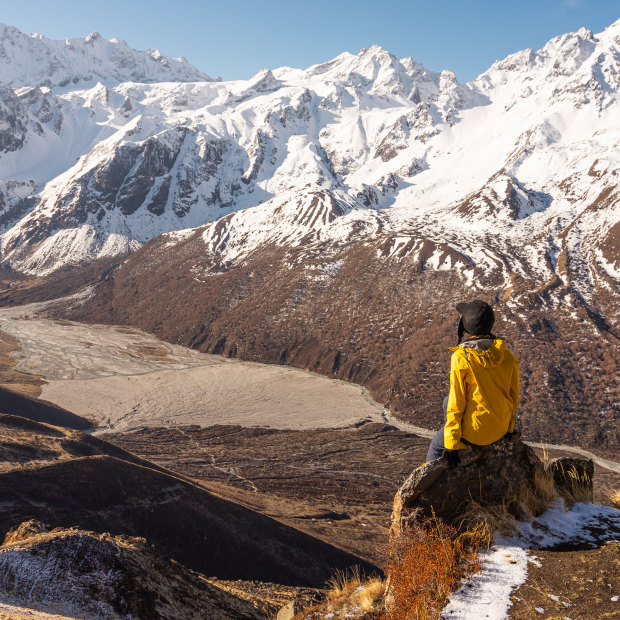
Almost 10 years after its devastating earthquake, Nepal has changed. But many of the best things about the country haven’t.Credit: iStock
At 5am, the sky above the world’s highest mountain is bright with the promise of a new day with Mount Everest already spinning fairy-floss clouds around itself, even as the neighbouring Himalayan peaks remain dark silhouettes.
I’m on the trail, like so many others here, towards Everest Base Camp (EBC), the most popular trek in Nepal.
Up here in Pangboche village the only thing that breaks the silence amid a forest of Buddhist stupas and prayer flags near the foot of a monastery, is the occasional sound of a tent zip.
On this visit, I’m taking part in World Expeditions’ 12-day Everest Trek in Comfort tour. Home last night was one of the newest of five semi-permanent campsites dotted through the villages of the Khumbu region that have been established by the Australian adventure tour company.
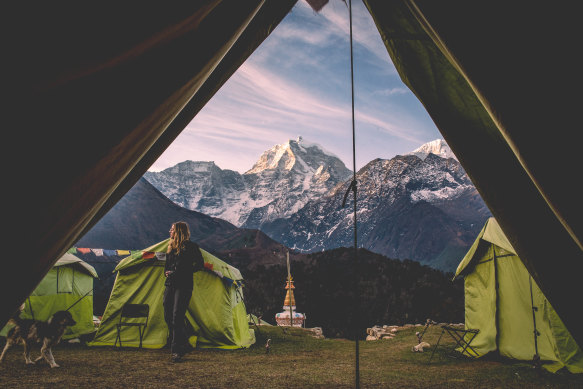
The view from your tent at Pangboche will help you rise early.Credit: Tim Charody
These camps add levels of comfort above those of traditional Nepalese “teahouses” (mountain lodges providing meals and accommodation along trekking routes), broadening their appeal to trekkers, while also taking control of the food preparation and hygiene in the kitchens.
The first of the camps was set up in 2016, one year after Nepal’s tragic earthquake, and their presence is now just one of so many changes in Nepal’s mountains since the natural disaster.
In 2015, I was in Nepal just days before the earthquake. I’m back to continue my trekking love affair with the country, drawn by the appeal of Mt Everest, and heading anew into Langtang, one of the regions most devastated by the disaster.
Since then roads have continued to push through trekking valleys, the mountains of rubbish among the planet’s tallest mountains have come into focus, and villages have risen anew from the rubble of the quake. For me, this visit is a chance to embrace the change, and treasure the unchanged.
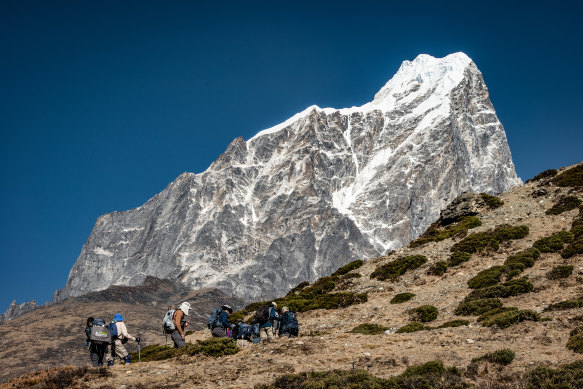
Hikers are pouring into the region.Credit: Tim Charody
Camped in the Khumbu
For trekkers into the Khumbu, the changes begin as early as check-in. No longer do flights to Lukla – the start of the trekking route – depart from Kathmandu, taking off instead from an airstrip at Ramechhap, about a five-hour drive east of the capital.
In the past, flights from Kathmandu airport would skim low over a Himalayan ridge before landing, belly flop-like, on the steeply sloped Lukla runway, earning it a reputation as one of the world’s most dangerous flights.
From Ramechhap, the 20-minute flight follows a less alarming flight path, heading up a valley and landing smoothly on the mountain airstrip, where the trail to EBC begins through an avenue of outdoor-gear stores, teahouses and perhaps the world’s only Irish pub with prayer wheels at its door.
For two to three days, the trek gives away none of its mountain secrets, staying low in the Dudh Kosi valley, out of sight of the top-billing peaks, before rising towards Himalayan heights on a long and dusty climb into Namche Bazaar, the largest settlement in the Khumbu.
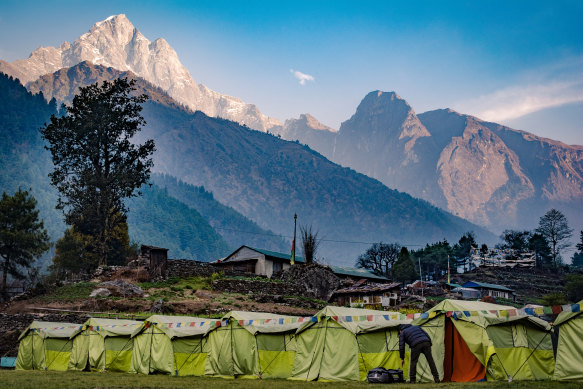
The route to Himalayan heights gains altitude at spectacular Ghat.Credit: Tim Charody
In their haste for the mountains, most trekkers march without pausing through the village of Ghat, two hours’ walk from Lukla, but it’s here that we spend our first night, aiding our acclimatisation and equally aiding a local family and lodge.
When World Expeditions’ camps were established, I was among the first people to stay in the new tents. Others I spoke to during that visit shared my reservations about the impact of such camps on the villages through the valley.
Would they be detrimental to the custom of local tea houses and lodges? Would they create a disconnect between trekkers and locals?
In Ghat, the camp is set on lawns behind a lodge, with only the bells of passing mule trains as a reminder of the trail’s proximity. The land is leased from the lodge owner, an elderly, ever-laughing woman named Gaga Maili. Tents ring the lawns, which are edged in turn by garden beds filled with vegetables.
“Before, we were totally dependent on farming,” Maili says, explaining that she used to grow corn to feed animals, and potatoes that had to be hauled to markets.
After the death of her son, she took on the running of the lodge, which now brings in enough income from the World Expeditions camp that she no longer needs to take in other trekkers.
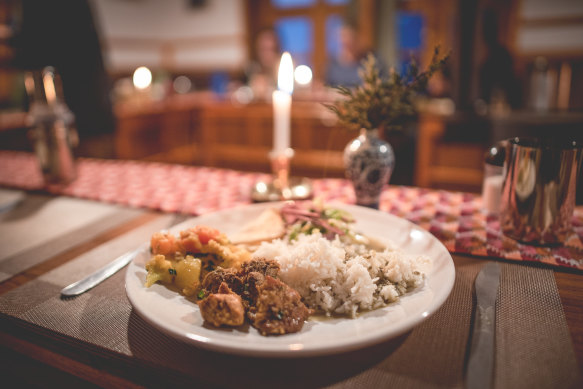
Hearty meals for trekkers prepared by World Expeditions cooks in the new camps.Credit: Tim Charody
The vegetables, from the potatoes, bok choy and garlic growing behind my tent to a greenhouse filled with cauliflowers, are now grown exclusively for the consumption of camp guests.
Such greenhouses, now dotted along the lower trail, are a sign of change in the Khumbu. They appeared five years ago, allowing teahouses and families to grow produce out of season, as well as the likes of tomatoes that had never grown in this environment.
“We’re self-sufficient,” Maili says. “What I grow here is only enough for the groups. Everything goes to the trekkers, the porters, the staff and ourselves. I’m very, very happy that I got this opportunity.”
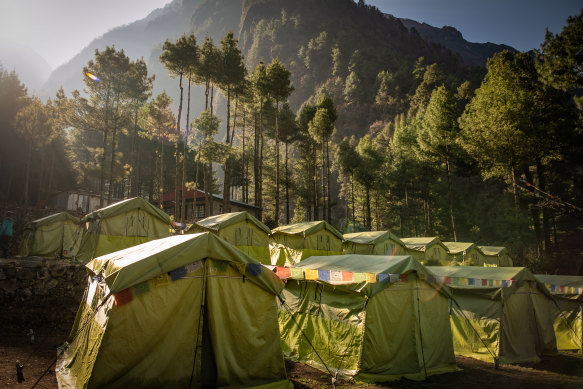
Monjo Eco-Comfort Camp.Credit: Tim Charody
It’s a story that echoes along the trail. In strung-out Monjo, another day’s walk up the valley, the campground was leased almost 10 years ago from a village woman named Dali, who previously ran a basic, barely sustainable teahouse for local porters.
Today, Dali’s new house is across a field from the camp. Built from the funds she’s received from the camp, it’s the first proper home Dali has ever owned.
“She started to get rent from us, as well as the food that we buy from her,” says trek leader Bir Singh Gurung. “In that way, after 10 years, she has managed to upgrade herself from poverty to, I would say, a middle-class family. She is having a better life.”
Monjo marks the entrance to Sagarmatha National Park, the World Heritage-listed reserve that encompasses three of the planet’s 10 tallest mountains, including Everest.
Villages continue to dot the trail – about 10,000 people live in the national park – and a constant tide of trekkers pours in and out of the park entrance gate.
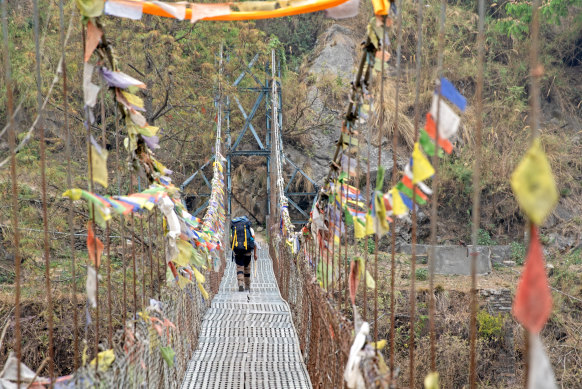
Suspension bridge over the Trishuli River at the start of the Langtang trek.Credit: Tim Charody
More than 80,000 trekkers hike through the Khumbu each year and there are moments, such as watching up to 100 trekkers at a time squeezing across suspension bridges over the Dudh Kosi, that I despair at the volume of humanity seeking a glimpse of Everest.
But there are many more moments when I’m reminded why we’re all here. It’s in watching young monks playing in the grounds of Tengboche Monastery, with Everest rising over the shoulders.
It’s hearing the soundtrack of yak bells as the animals haul loads through the upper valley. It’s finding a sudden pocket of space and solitude inside a towering, flowering rhododendron forest.
It’s stepping from my tent on frost-coated mornings to find the most famous skyline in the Himalayas radiant with the day’s first light.
In their first incarnation, these camps, which go as far up the valley as Dingboche – beyond Dingboche, the land is government-owned and can’t be leased – were an eyesore. The bright orange tents were more conspicuous than the villages around them.
Those tents have recently been replaced by more muted green tents, among numerous other camp upgrades. There are now candlelit dinners, tiny vases of wildflowers that brighten the tables, and even plating to add a touch of glamping to the camp dinner experience.
The tents have raised beds and thick mattresses, and each camp’s purpose-built stone dining room has been renovated and re-furnished in traditional Nepali style. To avoid further felling of trees in the valley, fires in the dining rooms are fuelled by yak dung and offcuts of wood from construction jobs in the villages.
But still the greatest luxuries are found outside, in the view. The camps have an ascending scale of beauty – each one more spectacular than the last – until above Pangboche, in the thin air at 4000 metres above sea level, the striking, thumb-like figure of Ama Dablam towers immediately overhead and Everest looms large just beyond. It’s a grandstand to grandeur as much as a camp.
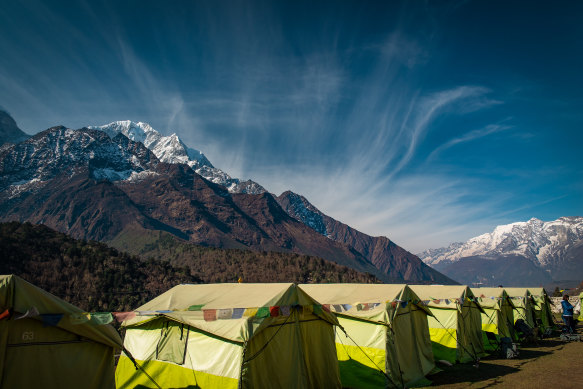
Pangboche, at 4000m, is a “grandstand to grandeur”.Credit: Tim Charody
Keep the Himalayas beautiful
The accumulation of rubbish on Mt Everest has been well-documented, with a 2020 study finding that 50 tonnes of rubbish had been left on the world’s highest mountain in the previous six decades. But the problem isn’t confined to the high slopes and the world of mountaineers.
The trekking route to EBC is paved in waste – plastic wrappers, bottles, toilet paper, human faeces – and dealing with the rubbish created by tens of thousands of trekkers, along with associated guides, porters and teahouses, is one of the great modern dilemmas of the trail.
Above Namche Bazaar, a curving stone building sits alone beside the trail as we climb towards Khumjung. Constructed over five years, it opened in 2022 as the base for the non-profit environmental group Sagarmatha Next and is filled with galleries of artworks made from repurposed rubbish.
There are installations constructed from discarded metal that fill rooms right down to tiny gift-shop dioramas of the mountains around Everest, each one made by melting down 38 plastic bottle caps, which otherwise can’t be recycled.
Sagarmatha Next’s greatest initiative, however, is the “Carry Me Back” scheme. Run in conjunction with the Sagarmatha Pollution Control Committee (SPCC), it encourages trekkers to pick up and carry out a one-kilogram bag of rubbish as they return down the trail from EBC.
Tom Gustafsson, one of Sagarmatha Next’s trio of founders, says that in the first three years of the scheme, more than 10,000 trekkers carried out 18,000 tonnes of rubbish.
“I’ve heard that’s skyrocketed this year,” Gustafsson says. “We invite artists from different countries to come and use the waste to make artworks, but still 90 per cent of the waste is out there.”
Sagarmatha Next is not alone in its quest to cleanse Everest’s landscape and image. Since 2014, every climber on Mt Everest has been required to bring back eight kilograms of rubbish or forfeit a $4000 deposit.
That year, World Expeditions was a founding partner of 10 Pieces, in which trekkers voluntarily commit to pick up 10 items of rubbish each walking day.
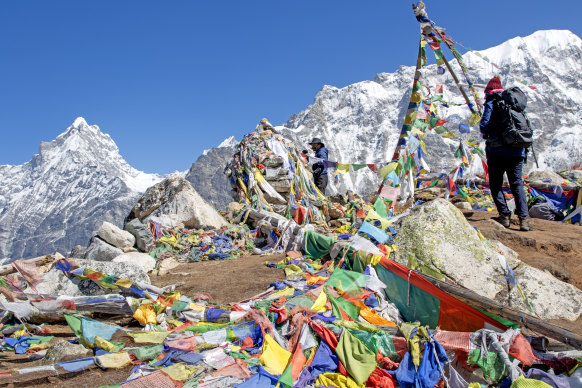
Trekkers are encouraged to take out their rubbish, and more.Credit: Andrew Bain
Under the Carry Me Back scheme, rubbish is sorted, shredded and stuffed into dry bags by SPCC workers. These bags are available for collection at a trekkers’ checkpost near the entrance to Namche Bazaar, where, two days from the end of our trek – legs strong, lungs reinflating with oxygen as we descend – we pause to gather bags of this waste, clipping it to our backpacks.
We aren’t alone in this task, with rubbish bags swinging like metronomes from myriad packs as we make the long descent from Namche Bazaar back to the Dudh Kosi.
At the trail’s final checkpost by the entrance gate to Lukla, we drop the bags outside a doorway, from where they’ll be gathered and eventually flown to a recycling centre in Kathmandu, ridding the Khumbu of rubbish one kilogram at a time. “If we got all the people who trek to take a bag back, we’d have no more waste,” Gustafsson says.
Rising from the rubble
No place tells the story of Nepal’s earthquake as tragically as Langtang Village. When the 7.8-magnitude quake struck on Anzac Day 2015, a hanging glacier on the highest peak above the Langtang Valley fractured, triggering a massive avalanche that engulfed Langtang Village.
More than 240 villagers and trekkers were killed, and the largest settlement in Nepal’s third most popular trekking region was wiped from the map.
After returning from the Khumbu at the end of my World Expeditions trip, I stay a night in Kathmandu before setting out independently for the Langtang Valley. Though just 100 kilometres by road north of Kathmandu, it’s a bruising seven-hour bus ride to Syabrubesi, abutting the Chinese border at the mouth of the valley.
I will spend six days on foot with a local guide, tracing the valley through to the mountain-ringed monastery village of Kyanjin Gompa, but it’s the devastation and regeneration of Langtang Village that has drawn me here.
The guiding line for this trek is the Langtang Khola, the river that pours furiously through the valley, with the roar of its rapids surpassed in volume only by the chorus of birdsong in the forest along its lower banks.
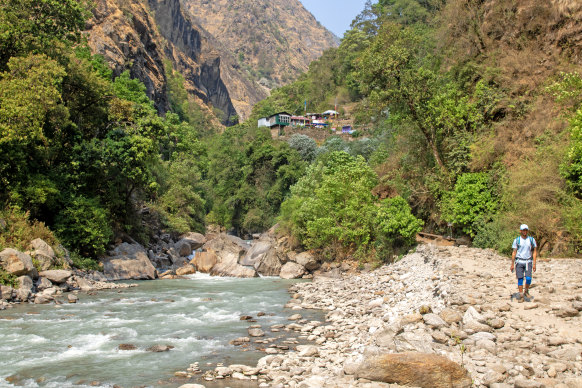
Trekking beside the rushing snow melt of Langtang Khola.Credit: Andrew Bain
The first glimpse of Langtang Lirung, the 7246-metre mountain on which the avalanche began, comes just beyond Lama Hotel, a tiny village of trekking lodges squeezed among riverside boulders.
Our objective today is a rebuilt Langtang Village. Mountains and monkeys surround us as we pass through Riverside Lodge, with trekkers on one side of the river and dozens of langur monkeys on the opposite bank, all staring across at each other.
As Langtang Village comes into view, so too does a raw scar on the mountain above. The pathway of the avalanche is a slope scoured bare, with a massive pile of rubble at its base. Beneath the rubble is the site of the old village, still buried along with its dead.
The trekking route now crosses atop the rubble, passing a recently erected memorial to the dead placed above the site of the former army barracks in the village.
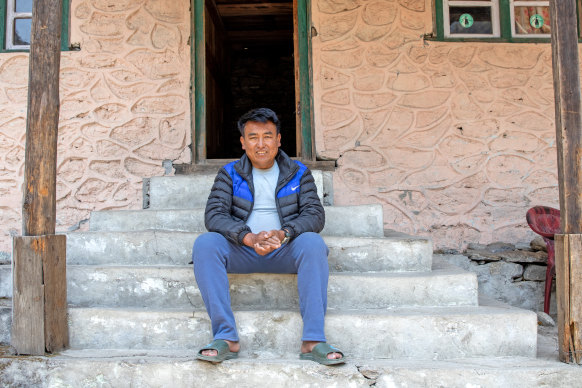
Tsering Lama in Langtang Village.Credit: Andrew Bain
To trek across this river of rock and earth, which is several hundred metres wide, is to walk on a land feature that didn’t exist 10 years ago, and it’s hard to step here, walking over the lost lives beneath, without feeling a deep sense of grief.
Immediately beyond the avalanche path, on an elevated bench of land, a new village has slowly emerged in defiance of the destruction. Still no more than a nascent smattering of lodges, the village looks unfinished. A monastery remains under construction, and most of its lodges still have bare concrete walls.
I stay the night in the Valley View Lodge, where the window of my room looks out over grazing yaks to the landslip and the buried village.
In the dining room I meet Tsering Lama, the lodge owner. Born and raised in Langtang Village, Tsering and his family owned a lodge in the old village, but on the day of the earthquake, he was down the valley at another lodge he owns in Lama Hotel.
His mother was looking after the Langtang Village lodge and was killed in the avalanche. All of Langtang’s surviving villagers were eventually evacuated to Kathmandu. Two years later, Tsering returned to build the first lodge on the land that would become the new Langtang Village.
“Others were afraid, and when I built, they began to build their lodges as well,” he says. “We slept in a tent and in the daytime, we were working to rebuild. Only a few trekkers came then.”
Today, about 20,000 trekkers head through the valley each year. Many of them are Nepalis, as Langtang is the closest trekking region to Kathmandu, just a $15 bus ride away.
From Langtang Village, it’s another day’s trek up the valley to Kyanjin Gompa, a village as colourful as it is beautiful. A wall of white mountains prevents progress beyond, but over the next couple of days, we climb two trekking peaks above the village – 4773-metre Kyanjin Ri and 4984-metre Tsergo Ri – before retracing our steps through the Langtang Valley.
Passing back through Lama Hotel, I encounter Tsering Lama again, sitting out front of his Lama Guest House, with sheets from the beds drying in the breeze around him. I pull up a chair beside him as he talks of the valley’s history and his father’s role in setting up one of the valley’s first lodges in Langtang Village in 1970.
“He didn’t know how to build a lodge or what Westerners would want, but he had two American friends who helped him set it up,” Tsering says. On the walls inside the Lama Guest House hang a pair of photos of Langtang Village before the earthquake.
As I walk on, I pause at the base of the village and look back to where Tsering remains sitting, looking out over the rusted rooftops of Lama Hotel and the trekker traffic heading up and down the valley.
Almost a decade on from devastation, the scars remain in the land and the people, but for the moment it looks like nothing more than a man out enjoying the mountain sun.
Five more things to do and see in Nepal
Explore the Kathmandu Valley
Now tightly packed with the sprawl of the capital city, the Kathmandu Valley was once three separate kingdoms: Kathmandu, Bhaktapur and Patan. Take a couple of hours out from central Kathmandu to visit the Durbar Squares (the old royal squares) in Bhaktapur and Patan.
Visit the capital’s temples
Kathmandu has a trio of fascinating religious sites: one of the world’s largest Buddhist stupas at Boudhanath; the Hindu funeral ghats at Pashupatinath; and the lofty city views (and monkey mayhem) of Swayambhunath, aka Monkey Temple.
Bungee off Hillary Bridge
Launched just a couple of months ago, Everest Bungee offers plunges from the Hillary Bridge – alongside the EBC trail – below Namche Bazaar. For those who dare, it’s 44 metres of freefall towards the Dudh Kosi rapids.
Zip off to Nepal’s second city
Pokhara, the launch pad for Annapurna treks, has emerged as one of Asia’s premier adventure centres – raft the Seti River, hurtle down one of the world’s steepest zip-lines, or paraglide along the face of the Himalayas.
Walk on the wild side
At Chitwan National Park, in the humid lowlands of Nepal, encounter wildlife such as rhinoceroses, elephants, Bengal tigers and gharial crocodiles, on dugout-canoe or vehicular safaris.
THE DETAILS
TREK
World Expeditions’s 12-day Everest Trek in Comfort trip from $3590 a person includes stays in its camps through the Khumbu Valley as well as a lodge in Namche Bazaar. See worldexpeditions.com
PACK
The Everest Base Camp Trek in Comfort trip includes the use of a down jacket and a warm sleeping bag and liner. Bring other warm gear – nights get cold at altitude – and good, worn-in hiking boots. World Expeditions provides a detailed packing list with its booking documents.
KNOW
Altitude sickness is possible above 3000 metres (EBC is at 5364 metres). Follow guidelines to ascend no more than 300 metres a day, talk to your GP about altitude sickness drugs such as Diamox, and ensure your health insurance covers medical evacuation while trekking.
FLY
Malaysia Airlines and Thai Airways fly from Australia with connections to Kathmandu, the Nepalese capital, transiting in Kuala Lumpur, Malaysia, and Bangkok, Thailand, respectively. See malaysiaairlines.com; thaiairways.com
MORE
ntb.gov.np
The writer travelled as a guest of World Expeditions.